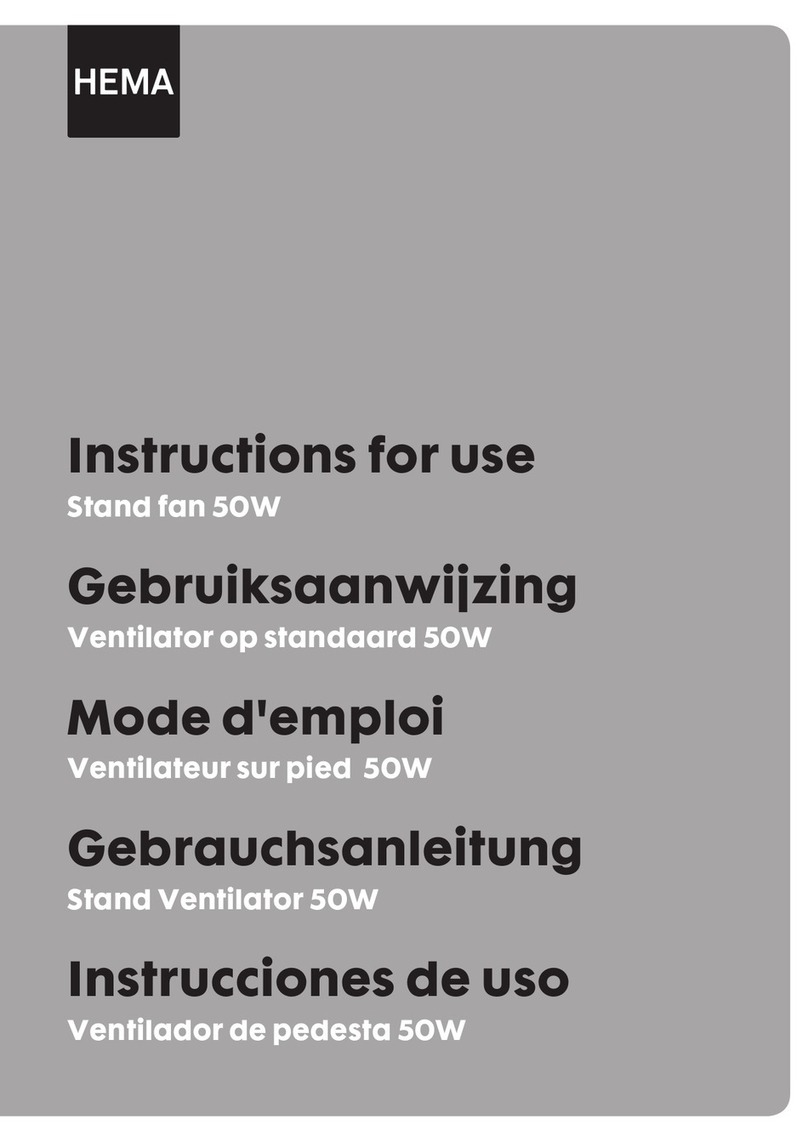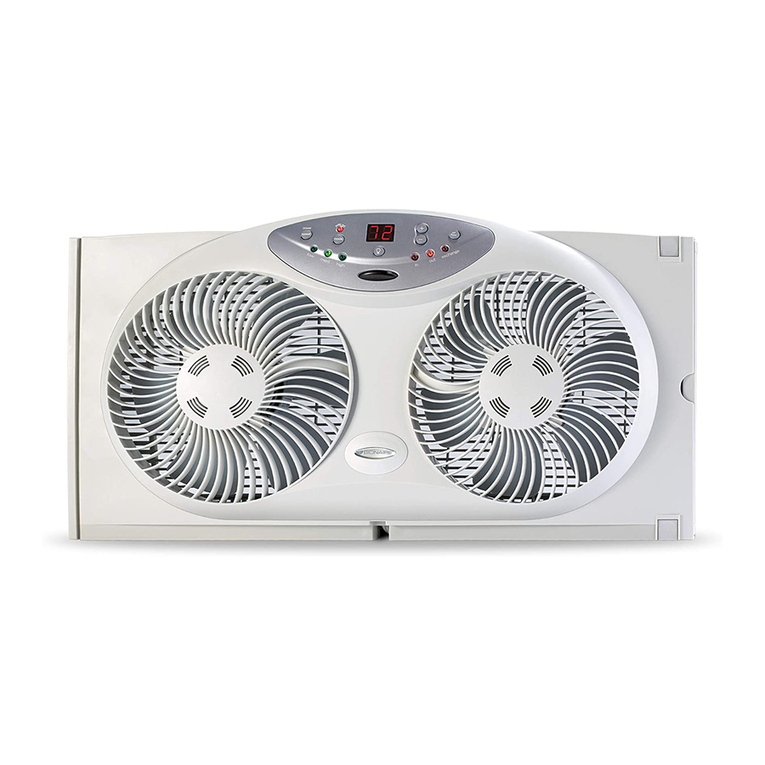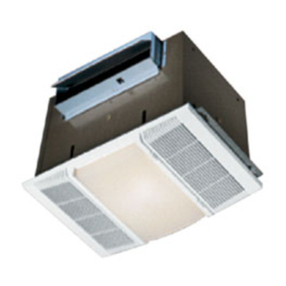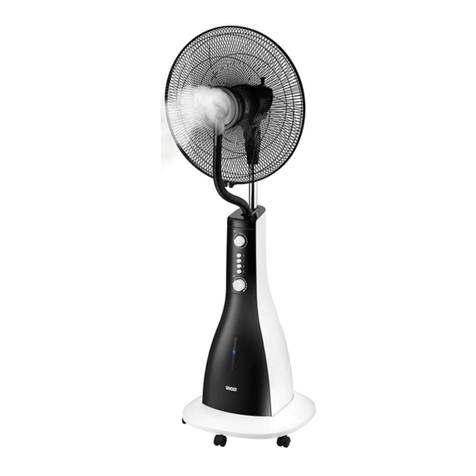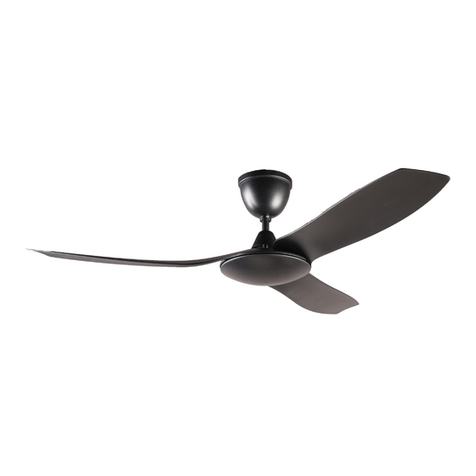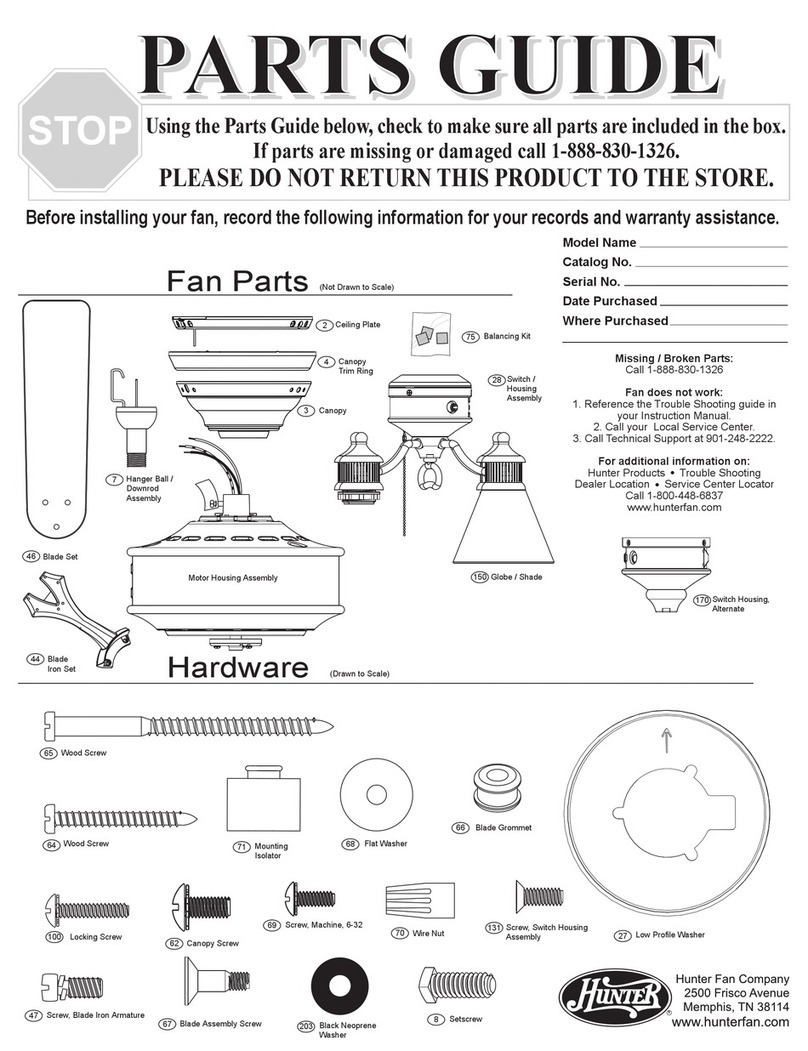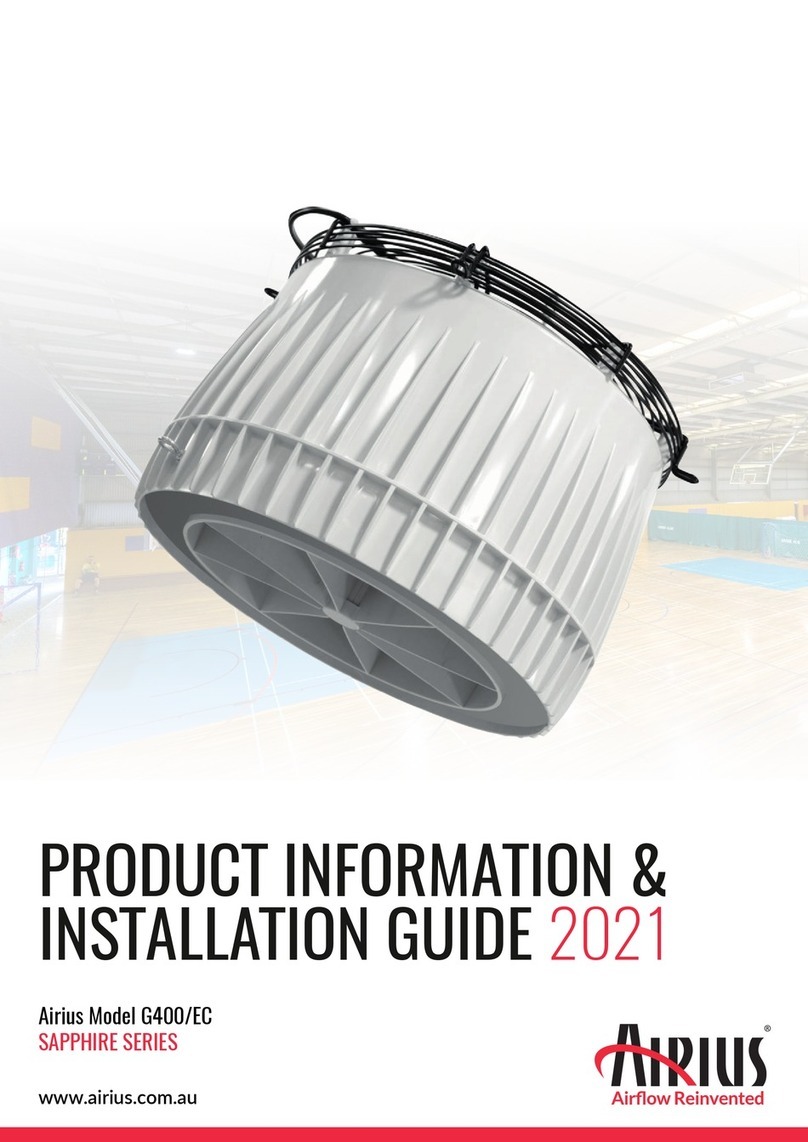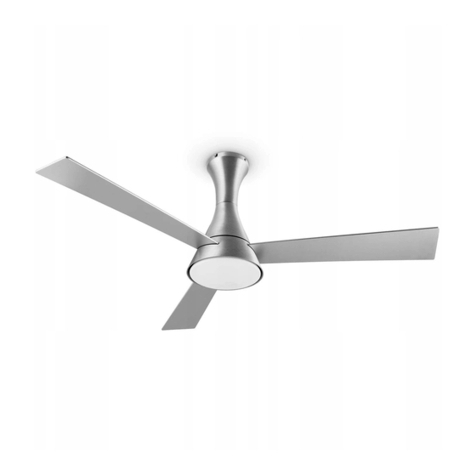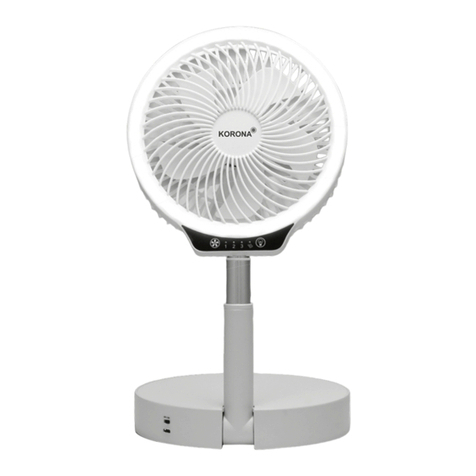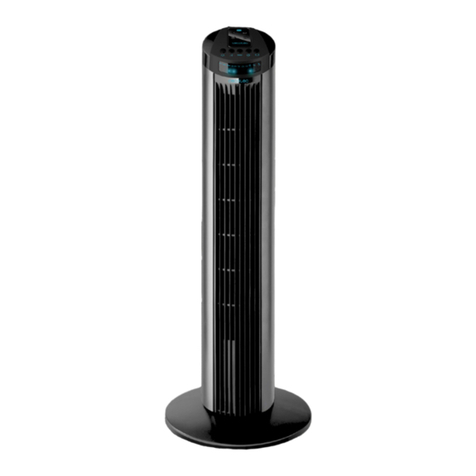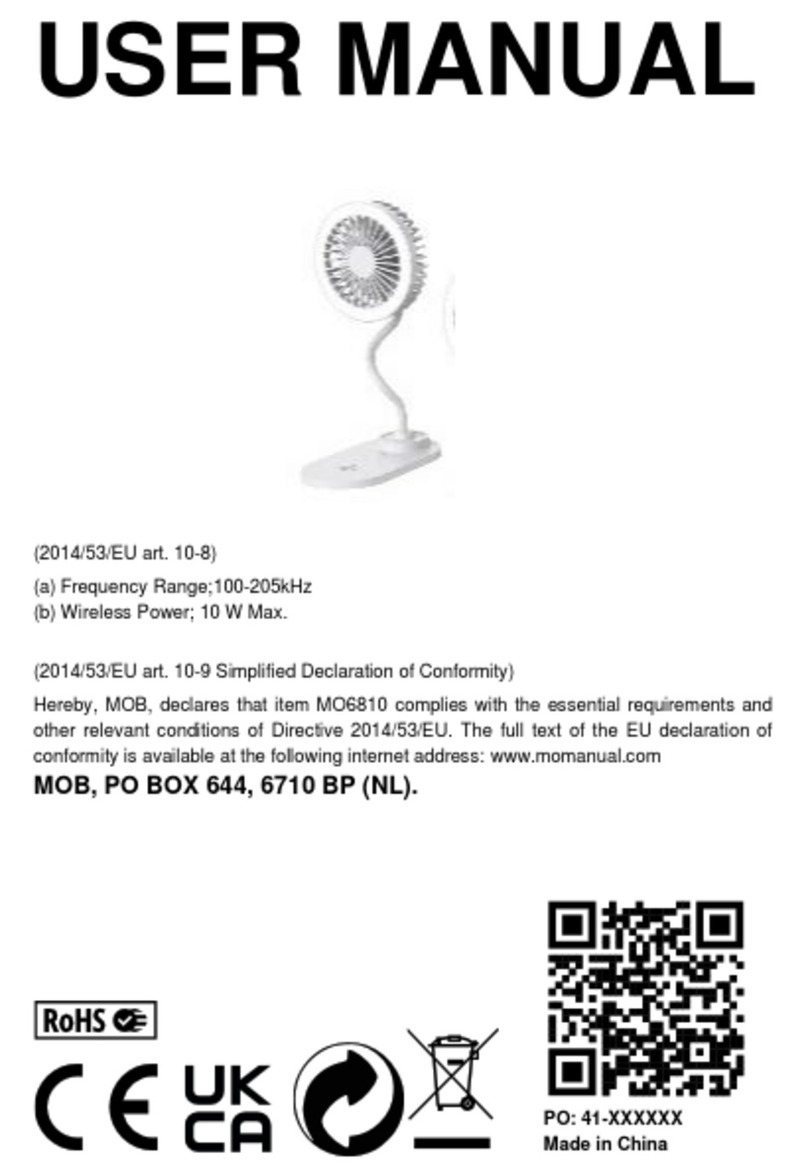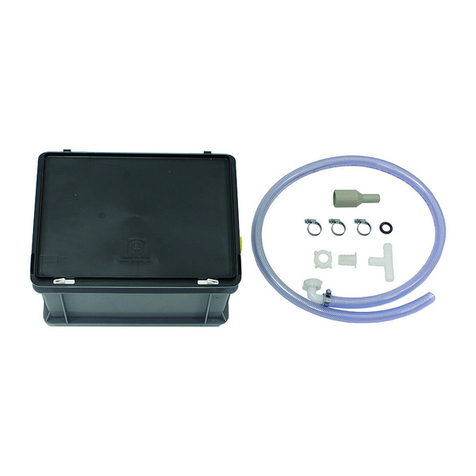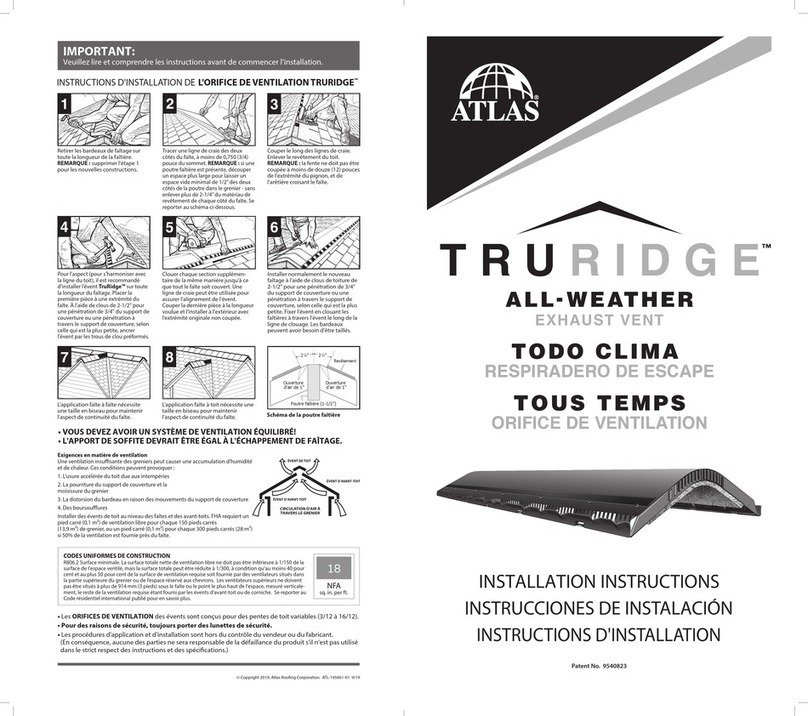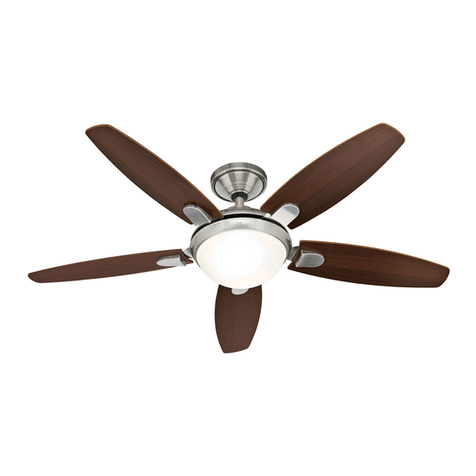Trion Grease Viper Series User manual

TRION®| www.trioniaq.com
Grease Viper Series
Electrostatic Precipitators
Commercial & Industrial Applications
READ AND SAVE THESE INSTRUCTIONS

www.trioniaq.com Grease Viper
1
Installation, Operation, & Service Manual
Electrostatic Precipitators for Commercial & Industrial Applications
Grease Viper
Custom Electronic Air Cleaner
Table of Contents
Section I - Design
For the System Design Engineer
1. General Description...................................................................................................................................2
2. System Design and Layout........................................................................................................................2
3. Outdoor Installations..................................................................................................................................3
Section 2 - Installation
For the Installing Contractor
1. Unpack and Inspect...................................................................................................................................4
2. Position Air Cleaner Cabinet......................................................................................................................5
3. Connect Adjoining Ductwork......................................................................................................................5
4. Mount Detergent System............................................................................................................................5
5. Connect Drain...........................................................................................................................................5
6. Connect Water Wash Supply.....................................................................................................................5
7. Mount Control Panel...................................................................................................................................6
8. Complete Wiring
a. Primary Wiring......................................................................................................................................6
b. Grounding.............................................................................................................................................6
9. Checkout for System Start-up....................................................................................................................6
Section 3 - Operation & Service
For the Maintenance Engineer
1. Introduction and Principle of Operation......................................................................................................6
2. General Description...................................................................................................................................7
3. Initial Start-up...........................................................................................................................................7
4. Wash Control and Detergent System Settings...........................................................................................9
5. Routine Maintenance...............................................................................................................................10
6. Periodic Maintenance..............................................................................................................................10
7. Troubleshooting.......................................................................................................................................11
Troubleshooting Reference Chart............................................................................................................13
8. Spare Parts.............................................................................................................................................14
Warranty Statement.....................................................................................................................................14

www.trioniaq.com
Grease Viper 2
Installation, Operation, & Service Manual
Design
FOR THE SYSTEM DESIGN ENGINEER
1. General Description
The standard major components supplied with each
unit for installation are as follows:
• Inlet Plenum Section with Grease Bafe Impinger
Prelters
• Electrostatic Precipitator (ESP) with Integral
Power Supplies
• Control Panel
• Detergent System
• Water Wash Solenoid Valve(s), ‘Y’ Strainer, and
Detergent
• Odor Control Section
• Optional Exhaust Fan
Stage 1 of the Grease Viper System is an Inlet Plenum
Section with Grease Bafe Impinger Prelters.
Stage 2 of the Grease Viper System is an ESP that
provides primary ltration and contains the following
components:
• Ionizing/Collecting Cells (collecting elements)
• Aluminum Mesh Afterlters
• Wash Manifolds - located both above and
upstream of the Cells
• Optional Pre-piped Fire Suppression Nozzles
Stage 3 of the Grease Viper System is an optional 2nd
stage ESP Section that provides secondary ltration
to the 1st Stage ESP for both increased collection
capacity and efciency. 3rd stage ESP sections are
also available.
Stage 4 of the Grease Viper System is an Odor
Control Section. Panels, lled with activated carbon
granules, are arranged in a V-shaped bank providing
a large surface area for the air. The surface of each
granule is extremely porous and absorbs materials
that are in a gaseous or vaporized state that cannot
be removed by the previous lter sections. Using the
carbon lters without pre-ltration by a 2nd stage ESP
is not recommended. When the panels have become
saturated or fully loaded they may be replaced with
new panels or reactivated carbon.
Gasketed access doors located on one side of the
cabinet, 90 degrees to the direction of the airow,
provide entry for removal of the cells and lters. The
location of the access doors may be specied as right-
hand or left-hand access - determined by facing the
inlet of the ESP (dirty airow at your back).
The solid-state high voltage power supplies are
factory installed and wired within an enclosure on
ESP access doors.
The control panel consists of a NEMA 12 enclosure
designed for remote mounting and houses power
supply transformers and electrical components for
initiating and sequencing the wash cycle. In addition,
the control panel is a central junction for the primary
wiring. The detergent system is furnished as a
completely assembled unit to be piped directly to the
wash water supply, into the wash manifolds.
Note: 16, 30, or 55-gallon detergent tanks are available
as an option.
The strainer is to be installed in the main wash
water supply line. Back ow preventer and/or check
valves should be installed according to local code
requirements - these items are not provided as part of
the system accessories.
When furnished, the Exhaust Fan (optional) has
been sized to handle the air ow and static pressure
requirements for the Grease Viper System and the
adjoining hood ductwork.
2. System Design and Layout
The arrangement of the supplied components and
the general layout of the system will vary according to
application, adjoining equipment, and available space.
However, there are several basic factors pertaining to
all installations that must be considered:
NOTE
TRION®Tridex Detergent is specially formulated
for use with TRION® electronic air cleaners. Use
of other cleaners and detergents, not specically
approved by TRION®, can cause possible failures
in the unit and will void any and all warranties on
our equipment.

www.trioniaq.com Grease Viper
3
Installation, Operation, & Service Manual
To maintain the selected cleaning efciency, it is important
to assure that the total air volume (capacity in CFM) is
uniformly distributed across the entire face area of the
unit - the prelters and after lters provide some airow
resistance to inuence uniform air distribution. However,
since most duct systems are designed to handle air
velocities greater than the rated velocity of the air cleaner,
it is necessary to properly transition any attached ducting.
If possible, a contraction angle of less than 60° should be
maintained. If space prohibits, turning vanes, air bafes,
or other means may be utilized. Ducting – where attached
to the cabinet – should be gasketed, caulked or otherwise
made watertight (and in accordance with NFPA 96 on
commercial cooking exhaust applications).
Contaminants to be collected – such as oils in vaporous
state – must be condensed into particulate form prior
to entering the ionizing-collecting cells in order to
maintain the anticipated efciency. Gases, vapors
or any nonparticulate cannot be precipitated and will
therefore pass through the ESP. Any condensing that
takes place downstream from the ESP defeats the
purpose. By the same token, heavy concentrations
of water vapor, or other matter that becomes highly
conductive when condensed, must be prevented from
entering and/or condensing in the collecting elements
to prevent electrical arc over and shorting.
Individual drain lines from the drain basin of each
section should be trapped or otherwise sealed against
the system pressure (in accordance with local codes)
to prevent air bypass. Wash water to the unit must
meet the volume required for the specic unit involved
and must be between 40 psig min. to 60 psig max.
at full ow to provide proper spray patterns from the
wash nozzles. The wash water MUST be hot (140°F
recommended) and installed as close as possible to
the unit and detergent system. Where applicable, all
water lines must be protected from freezing.
SAFETY NOTE
Factory designed access to all electrically
charged high voltage components contain
electrical interlocks for the safety of operating
personnel. Any additional access that may be
provided in the system, where there is access
to high voltage, must be equipped with such
interlocks. Interlocks are readily available from
the factory.
Each installation varies according to needs, but
normally the control panel is located indoors near the
ESP. Ideal mounting height is at eye level for ease in
reading the instrumentation and to facilitate service.
For ease in maintenance and component removal,
adequate space must be provided in front of all access
doors, motors, pump and accessory equipment.
Special consideration should be given in this respect
for installations where the unit is suspended overhead.
Catwalks or platforms should be provided.
3. Outdoor Installations
Requirements for outdoor protection vary in
accordance to climate and equipment component
arrangement for the particular job. The best approach
for equipment protection is the construction of a
heated shed or building over the installation. As an
NOTE
THE HOT WATER TANK IS NOT PROVIDED
BY TRION®.
CAUTION
In addition to the above space requirement,
installation of the Grease Viper in NFPA
applications shall have a clearance of at least
18 inches to a combustible material, 3 inches
to limited combustible material, and 0 inches
to noncombustible material. Any reduction in
clearance or exceptions must be in compliance
with NFPA and acceptable to the Authority
Having Jurisdiction.
WARNING
Fire Suppression System
Extreme caution should be exercised when this
unit is installed in applications that are collecting
volatile or potentially ammable contaminants
such as cooking grease and petroleum based
oils. TRION® strongly recommends a re
suppression system be installed in the ductwork
and on the Grease Viper in cases where these
contaminants are collected on the cell plates and
collect on the attached ductwork. Contact the
factory for questions or concerns regarding a re
suppression system.

www.trioniaq.com
Grease Viper 4
Installation, Operation, & Service Manual
alternative, the installing contractor should treat the
equipment as required to meet the specic needs.
Detailed discussions of the installation components
are as follows, using a rooftop installation as an
example.
Adjoining Ductwork (not supplied by TRION®)
The ductwork located on the air entering side of the
cabinet, between the point where it penetrates the roof
and the cabinet, must be air tight to prevent the entrance
of moisture, especially if it is under negative pressure.
Ductwork must also be adequately insulated or other
means taken to prevent the formation of condensation
through temperature change. Condensation will short
out the ionizing-collecting cells. Insulation must be of
the outdoor variety.
TRION®Grease Viper Cabinet
The access doors on the Grease Viper cabinet are
gasketed, and the unit is basically sealed against air
leakage. The paint nish (epoxy) is for interior and
exterior use. Like the air-entering duct, the cabinet
must be insulated or other means taken to prevent
condensation from taking place, which results in
electrical shorting of the ionizing-collecting cells.
Insulation, when employed, must be suitable for
outdoor applications and when applied, consideration
given to all access door openings and electrical
interlock box covers.
Control Panel
The control panel is designed for remote mounting
indoors, protected from the elements. If located
outdoors with the cabinet, the control panel must at
a minimum be weather protected. In sub-freezing
climates, the control panel must also be insulated
and/or heat traced to prevent freezing.
Drain Lines
The drain lines, located under the section access
doors at the lowest point of the sectional drain pan,
should be pitched downward and piped with as short
a run as possible to the heated interior of the building
(preferably, straight down from the drain pan supply
through the oor). The recommended drain line trap, to
seal off the cabinet from the drain against the system
pressure, and the drain dump valve should be located
in the heated interior. If not installed in this manner,
heat trace or other means should be employed to
prevent freezing. Clean-outs are recommended to be
installed in all drain lines.
Wash Water Supply Line
The length of the wash water supply line between the
Grease Viper cabinet and the heated building should
be kept to a minimum. Preferably the line would go
through the roof directly below each precipitator
section. The strainer, pressure gauge (by others), and
back ow preventer (by others, if required) should be
installed indoors. Installed in this manner, a dumping
valve can be included in the supply line to drain
the remaining water from the wash manifolds and
prevent freezing. The normally open dump valve will
be energized to close when the water wash solenoid
valve is energized to open. The strainer and solenoid
valve(s) are supplied by TRION®. The dump valve,
back ow preventer, or check valve are to be supplied
by others.
If the above method is not employed, the water supply
line, and drain line must be heat traced and insulated
to minimize the potential for freezing.
Detergent System
The detergent system, designed for remote mounting,
should be installed indoors and piped to the water supply
line within the heated interior. Detergent feed line should
be piped with as short a run as possible and inject into
the wash water supply line as close as possible to the
Grease Viper water wash connection ttings.
Contact the local TRION®representative or the
factory if questions arise or any additional information
is required.
FOR THE INSTALLING CONTRACTOR
1. Unpack and Inspect
At the time the unit is received, all shipping containers
and their contents should be examined for damage.Any
damage occurring in shipment must be immediately
reported to the carrier, an inspection report completed,
and a claim led at the receiving point.
The unit cabinet is shipped completely assembled
and, where size permits, the ionizing-collecting cells
Installation

www.trioniaq.com Grease Viper
5
Installation, Operation, and Service Manual
are shipped inside the cabinet. On large units, the
cells may be shipped in separate containers. The
control panel, detergent feeder, odor control panels,
and other separate accessories are shipped in the
containers as noted on the packing list.
2. Position Air Cleaner Cabinet
To reduce weight for ease in handling, remove the pre-
lters, after-lters and the ionizing-collecting cells from
the cabinet, and place them safely aside. Position the
cabinet in the designated location giving consideration
to the following points:
• Ionizing/collecting cells require 30” clearance in
front of the access door for cell and mechanical
lter removal.
• Level the cabinet to assure proper drainage from
the drain pan.
3. Connect Adjoining Ductwork
The installation plan may call for adjoining ductwork
on the air entering and/or air leaving sides of the
cabinet. When adjoining ducting is to be installed, the
bottom of the horizontal duct runs should be relatively
at and sloped toward the cabinet drain pan for an 18-
inch length. As a result, any wash water splash back
occurring during the washing operation will drain back
into the drain pan.
Duct securement to the Grease Viper cabinet should
be made air and watertight by caulking, gasketing, or
welding (when required in accordance with local codes).
When an exhaust fan is installed downstream from
the Grease Viper cabinet, the ducting between the
cabinet and the blower will be under negative pressure
and should be made air tight to prevent inltration of
contaminated air in accordance with local codes.
After the ductwork has been installed, clear remaining
material or debris from inside ducts and bottom of
INSTALLATION WARNING
Precautions must be taken to protect the
Grease Viper System and its sub-systems when
installed outdoors or in extreme environments.
Condensation, freezing, and elevated
temperatures must be considered (see detailed
Warning on Page 6).
cabinet, then re-install the ionizing-collecting cells and
all other lters. When the ionizing/collecting cells are
reinstalled, the directional arrows on the cell end plates
must concur with airow direction through the cabinet.
Impinger prelters are to be installed within the inlet
plenum section on the air entering side of the unit.
4. Mount Detergent System
The detergent system should be located as close to
the unit as practical, but should not exceed 30 feet in
elevation difference. Service space must be provided
for periodic manual lling of the detergent tank and to
gain access to the pump and motor assembly. When
positioned, the assembly may be secured in place at
the predrilled factory mounting pads, either by bolting
or welding. Local disconnect is recommended at the
tank for pump motor service.
5. Connect Drain
Connect drain piping to the pipe nipples provided in the
cabinet drain basin in accordance with the governing
plumbing codes. The drain lines must be sealed with a
trap or other means to prevent air by pass. If a trap is
used, it should hold sufcient water column to overcome
the system air pressure and to assure that loss of liquid
from evaporation between cleaning periods will not break
the seal. The drain line should not be smaller than the
drainpipe connection, or it will otherwise restrict the ow
of water. Elevation of the equipment may be required to
allow adequate draining. Clean-outs are recommended
to be installed in all drain lines.
6. Connect Water Wash Supply
Solenoid valve(s), ‘Y’ strainer, and a detergent
tank/pump assembly are factory furnished for eld
installation. Flush entire piping system before
connecting to unit wash headers.
NOTE
Follow the directional arrows located on the cell
end plates. The side of each cell containing the
spiked ionizer blades must be located on the air
entering side of the cabinet. The brass contact
plungers on the cell must face the access door
side of the cabinet. Also, mist suppressors, when
specied, must be located within the optional
inlet plenum section on the air entering side of
the cabinet.

www.trioniaq.com
Grease Viper 6
Installation, Operation, and Service Manual
Unless otherwise specied, the water wash supply
should be hot (140°F recommended - WATER
HEATER NOT SUPPLIED BY TRION®)at the volume
specied for the given unit, and at a full ow pressure
between 40 and 50 psig measured at header.
Although not required, a pressure gage and a manual
service valve are recommended as shown in the
plumbing schematic (separate from this manual). The
components should be located within the system to
provide for service access.
7. Mount Control Panel
The control panel should be mounted indoors (unless
supplied with a weatherproof enclosure), at eye
level, and located as close to the ESP as practical.
Allow sufcient space in front of the access door(s)
for service. Refer to appropriate control panel outline
drawing for mounting hole layout and dimensions.
8. Complete Wiring
a. Primary Wiring: The control panel is the main
distribution point for all primary wiring. The various
electrical components involved are connected to
and powered from the control panel.
b. Grounding: An earth ground must be provided
to the Grease Viper cabinet and control panel. All
ground connections must be in contact with bare
metal and securely afxed. Ground conductor size
and connection means will be in accordance with
all applicable electrical code standards.
WARNING
Precautions should be taken in the event the water
supply, detergent piping, and drains are subjected to
freezing temperatures: 1) All plumbing components
– backow preventer, ‘Y’ strainer, pressure gauge,
solenoid valve(s), detergent system, drain valve,
and air gap tting - must be installed indoors or
in a heated mechanical room in accordance with
the plumbing schematic to prevent freezing. 2) All
piping exposed to cold climate outdoor conditions
should be heat traced and insulated to prevent
freezing. 3) An air gap tting should be installed on
the drain line to facilitate gravity draining of wash
water from the internal headers and manifolds.
4) The water supply line should be pitched back
toward the heated space.
9. Check Out for System Start-up
When the installation has been completed, assure
that the equipment is ready for start-up by checking
the following:
• All construction debris has been removed from the
ionizing-collecting cells, drain basin and ductwork.
• The inside of the control panel and detergent tank
are clear of any foreign materials.
• The drain lines from the Grease Viper drain basins
are clear and completely connected to their point
of termination.
• All piping is completed to the manifold headers
and wash water is available.
• Supply line power is available and electrical wiring
is completed to the following components:
a. Control Panel
b. Solenoid Valve(s)
c. Detergent Pump Motor
d. Electrical Interlocks
e. Power Supplies for Ionizing-Collecting Cells
f. Exhaust Fan
FOR THE MAINTENANCE ENGINEER
1. Introduction and Principle of Operation
The TRION®electronic air cleaner is technically known
as an Electrostatic Precipitator (ESP). In this type of
equipment, all airborne particles, even of microscopic
size, are electrically charged (positively) as they
pass through a high voltage ionizer. These charged
NOTE
Do not add the initial supply of detergent into the
detergent tank - this is to be done after volume
settings are adjusted at start-up.
Operation & Service
WARNING
RISK OF ELECTRIC SHOCK
These servicing instructions are for use by
qualied personnel only. To reduce the risk of
electric shock, do not perform any servicing other
than that contained in the operating instructions
unless you are qualied to do so.

www.trioniaq.com Grease Viper
7
Installation, Operation, & Service Manual
particles are then attracted and adhere to a series
of parallel collecting plates, which form the negative
elements of an electrostatic eld.
The ionizer consists of charged stainless steel spiked
blades spaced between grounded electrodes. The
collecting section consists of parallel plates arranged
so that each alternate plate is charged while the
intermediate plates are electrically grounded.
Periodically, depending on the type and concentration
of contamination in the air, the contaminant is washed
from the plates by the integrally constructed water
wash system.
Three major functional components comprise the air
cleaner:
• Ionizing-collecting cells to ionize and collect
airborne particulate matter.
• Power supply(s) to supply high voltage direct
current to the ionizing-collecting cells.
• Control operated wash system to automatically
wash away the collected contaminant.
Normally, systems are designed for collection
efciencies in the range of 90% DOP (0.3 micron) or
more. Collecting a contaminant at these efciencies,
especially when there are high concentrations, can
result in large accumulations in a relatively short
period. Therefore, maintenance must encompass
two areas: the operation of the equipment for efcient
collection, and the systematic removal of the collected
contaminant.
2. General Description
The inlet plenum contains grease bafe impinger
prelters to reduce airborne grease and mist
concentrations and provide resistance for uniform air
distribution.
The ionizing-collecting cells (contaminant collecting
elements) are housed in the ESP section(s) and can
be removed from the cabinet as required, through the
side access door, by sliding them out like drawers.
On multi-cell units, all of the electrical connections
between cells in a given tier are automatically made
through spring plunger connectors. Install cells into
the cabinet in accordance with the directional arrows
on the cell end plates. The side of the cell containing
the spiked ionizer blades must always be located on
the air entering side. The spring plunger connectors,
located on one end of each cell, will always face
toward the access side of the Grease Viper cabinet.
The power supply(s) convert the 24 volt, 60 Hz, single
phase AC supply to the high voltage DC required to
power the ionizing-collecting cells. Potential of 11.5
KVDC is required for the ionizer sections and 5.7
KVDC for the collector sections of the cells.
Metal mesh after lters, located downstream of
the cells in the last ESP section, prevent re-
entrainment of contaminants and wetting of the odor
control panels during the wash cycle.
The integral wash system consists of a series of spray
nozzles soldered into xed water wash manifolds.
The manifolds are located in the front and top of each
cell tier. A detergent system is also incorporated into
the wash system. The amount of detergent used for
washing is readily adjustable, and that amount is
dependent upon the type and amount of collected
contaminant.
The washing operation is cycled periodically - the
frequency is dependent on the type and amount of
contaminant collected. The sequential events in a
wash cycle are:
• Power Supply(s) and System Fan “OFF”
• Wash Water and Detergent “ON”
• Wash Water and Detergent “OFF”
• Pause for Detergent to react
• Wash Water “ON” (without Detergent for rinse)
• Wash Water “OFF”
• Pause for Drip Dry
• Exhaust Fan “ON” for forced air dry
• System Standby (Exhaust Fan and Power
Supplies “OFF”)
The time span for all of the events is factory set when
the equipment is initially ordered – see “Sequence of
Operation” in submittals.
3. Initial Start-up
1. Inspect the inside of the adjoining ductwork and
TRION®cabinet to be sure it is clean and free of

www.trioniaq.com
the liquid level in the tank. The usage should be
approximately 1 part of detergent to 20 parts of
water. The pump is a constant displacement type
and the amount of detergent forced into the water
supply to wash the unit is dependent upon the
setting of the control valve in the bypass return line
to the reservoir. The side of the translucent reservoir
is marked with volume markers. Adjust the control
valve to obtain the correct usage for the given unit
in accordance with the submittal outline data, and
then secure the setting with the Allen head set
screw located in the valve adjustment knob. When
the correct adjustment has been made, remove the
remaining water from the reservoir and ll the tank
with initial supply of detergent furnished, unless
Tridex concentrate mixture is being used.
11. Programming Time Clock for Automatic Wash
General Information
The panel-mounted digital timer
series included with the Grease
Viper can be operated in four
separate power supplies, ranging
from 240 VAC to 12 VDC. Output
format can be produced to be volt-
free or voltiac-output. Batteries of
lithium CR2032 or rechargeable
V80H are optional for retaining the programming during
timer’s disconnected operating power.
The digital timer is accurate to the minute, designed
with either six or eight ON/OFF (events) per day. It
also provides 15 combinations of daily programs
which can lead great convenience to users upon
choosing the required days in a week for operating
the timer.
Programming Functions
• TIMER: Programs review and setting programs
• MANUAL: To select “ON, AUTO, or OFF”
• CLOCK: To adjust current DAY and TIME
• DAY: To adjust day of week
• HOUR: To adjust hour
• MIN: To adjust minute
• P : Reset timer’s setting
• LED: To indicate ON/OFF status
Press P button to reset timer before programming.
Grease Viper 8
Installation, Operation, & Service Manual
any debris or construction materials. Especially note
the opening in the drain basin for any restrictions.
The ducting, where secured to the cabinet collars,
should be sealed water tight either with gasketing
or caulking.
2. Inspect the ionizing-collecting cells to see that all of
the ionizing blades are intact, that no large pieces
of foreign material are lodged between the plates,
and that the cells are properly installed in the
cabinet with the spiked ionizing blades located on
the air entering side and the brass contact plungers
facing the access side of the cabinet.
3. Conrm that the drain lines from the TRION® cabinet
drain basin are completely connected and properly
terminated. A trap or seal of some type should be
incorporated in each line to prevent air bypass.
4. Check the water supply line to be sure water is
available and that the strainer, solenoid valve(s),
and detergent system are properly installed and
connected.
5. Conrm that electrical power is available, that the
wiring is completed, and that the system exhaust
fan is ready to be energized.
6. Conrm that all access door interlocks are closed.
7. Close the system electrical supply switches, making
power available to the TRION®control panel and
the system fan.
8. Turn the selector switch on the control panel to the
“ON” position. Push ltration button on door. The
exhaust fan should run (if installed) and the power
supply(s) should be energized. Electrical arcing
within the ionizing-collecting cells may occur - this
is a normal occurrence caused by accumulation
of dusts from construction or other sources in the
cell(s) and should quickly subside.
9. Ensure the detergent tank is clean, and then ll the
tank 1/8 full with clean water. Do not ll the tank
with detergent until start-up adjustments have been
completed.
10. (Review this paragraph in its entirety before
initiating the wash start button.)
Manually initiate the wash cycle by pushing the
“Wash Mode” button on the control. The wash control
duration is 70 minutes and by means of a factory
preset programmable logic controller (PLC) will
sequence the washing events as previously outlined.
When the detergent pump is energized, note the
volume that is used by observing the reduction in
X
X

www.trioniaq.com Grease Viper
9
Installation, Operation, & Service Manual
Adjusting Clock
Press and hold CLOCK and then press DAY key, HOUR
key, MIN key respectively to adjust clock of timer to
accurate DATE, HOUR, MINUTE. In 12-hour format,
PM and AM shall appear on LCD screen. In 24-hour
format, LCD screen shall indicate 0:00 - 23:59.
Programming the Timer
1. Press TIMER key. LCD screen shall show 1ON.
2. Press DAY key to select any of the 15 combinations
of daily programs to your application demand.
Continuing to press DAY key will cause the LCD
screen to alternate among 15 combinations.
3. Press HOUR and MIN respectively to set desired
hour and minute for 1ON.
4. After nished setting 1ON, press TIMER key again.
1OFF should appear on the LCD screen.
5. Press DAY key to select any of the 15 combinations
of daily programs to your application demand.
Continuing to press DAY key will cause the LCD
screen to alternate among 15 combinations.
NOTE: Day combinations chosen in each of the ON/
OFF program periods must be consistent. The OFF
time settings for each period must be one minute after
the ON time setting.
6. Repeat programming procedure 3 to set desired
hour and minute for 1OFF.
7. When nished setting 1ON and 1OFF, press TIMER.
2ON shall appear on LCD screen.
8. Repeat programming procedure above to complete
the rest of ON/OFF program period event or just to
the desired number of ON/OFF (event) setting for
demand of practicable application.
9. When nished program setting (event), press
CLOCK. Timer shall start to execute programs.
Reviewing Programs
Keep pressing TIMER, and the display on the LCD
screen shall alternate display among each of 6 or 8
ON/OFF events.
Using Override Functions
Timer is designed with two override functions to widen
its usage among practicable applications. Override
function is only effective when timer is running in
AUTO mode.
Temporary Override
Condition 1: When timer’s output status is ON, press
MANUAL key to move indicator from AUTO to OFF.
Timer output shall turn to OFF status, programs
overrided. Press MANUAL again to switch timer status
to AUTO. Timer’s output shall continue maintaining
OFF. Timer shall resume its automatic operation
when next program (event) calls for ON (with next
opposite set point).
Condition 2: When timer’s status is OFF, press
MANUAL key to move indicator from AUTO to
ON. Timer status shall turn to ON status, programs
overrided. Press MANUAL again to switch timer status
to AUTO. Timer’s output shall continue maintaining
ON. Timer shall resume its automatic operation when
next program (event) calls for OFF (with next opposite
set point).
Random Startup Override: Press and hold DAY key,
and then press MIN key. There shall be a symbol
“nn” that shows on the left corner of the LCD screen
to indicate that this override is executing. When this
override is being executed, the original programs will
be stopped, and once every 10 to 120 minutes, timer
shall automatically turn its output to ON status. Once
again, pressing and holding DAY key and then MIN
key shall terminate this override.
For safe and proper operation, adhere to the
following instructions and procedures:
• Exhaust systems shall be operated during all
periods of cooking in restaurant applications.
• Filter-equipped exhaust systems shall not be
operated with lters removed.
• The posted instructions for manually operating
the re extinguishing system shall be kept
conspicuously posted in the kitchen and reviewed
periodically with employees by the management.
• Listed exhaust hoods shall be operated in
accordance with the terms of their listings and the
manufacturers instructions.
• Cooking equipment shall not be operated while its
re-extinguishing system or exhaust system is not
operating or otherwise impaired.
4. Wash Control and Detergent System Settings
Some contaminants are more difcult to remove than

www.trioniaq.com
Grease Viper 10
Installation, Operation, & Service Manual
others and require a stronger detergent solution.
Average settings have been factory set. Best possible
settings for any given installation, however, are
determined through experience. Determination can be
made by visually examining the collecting elements
after the rst few wash cycles.
To adjust the volume of detergent used within the given
time setting, loosen the knurled knob with an Allen
wrench on the control valve located in the by-pass
line. Refer to the Detergent System Outline. Turning
the knob clockwise increases the volume and counter
clockwise decreases the volume. When adjustment
has been made, be sure to retighten the setscrew.
5. Routine Maintenance
Washing Frequency
The frequency that the collected contaminant is
to be washed from the unit depends upon the type
and amount of contaminant in the air to be cleaned.
Contaminant which is greasy in nature tends to
harden after collection and should be washed away
often. Likewise, units operating under extremely
heavy contaminant loads should be washed more
often as a large build-up of collected material will have
a tendency to “blow-off” if permitted to remain on the
collecting elements for long periods of time. In that the
type and amount of contaminant varies geographically
(and from one location to another in any given area)
it is recommended to start operation with a washing
frequency of at least once a week. This schedule may
then be altered as needed after visual examinations
of the collected material contained on the ionizing-
collecting cells. Daily washing is not unusual for units
operating on heavy welding fume, kitchen exhaust
hoods or similar applications. Start time programming
is recommended to be within one hour of the end of
cooking time.
Detergent
Effective washing is dependent upon detergent. The
detergent reservoir should be examined on a routine
basis, a minimum tank level established, and never
permitted to empty. An empty tank not only means poor
washing, but can also be detrimental to the pump. The
inside of the tank should be kept clean, free from dirt and
foreign objects. The detergent, as supplied by TRION®,
is formulated specically for electronic air cleaners. If
substitutes are used, they must be approved by TRION®,
so as to not void the warranty. They should be safe for
use in ventilation systems and non-caustic, as 95% of
the ionizing-collecting cells are constructed of aluminum,
special high voltage insulation and gasket seals.
Electrical Operation
The ESP section(s) access doors have LED indicating
lights to show status of the power supplies. Illumination
of LED(s) indicates proper operation. Flickering or dim
LED(s) indicate arcing within the ionizing-collecting
cell(s). No illumination indicates lack of input power,
dead short in ionizing-collecting cell(s), failed power
supply, and/or failed LED.
6. Periodic Maintenance
Water Wash System - Every 6 Months
The water wash spray pattern should be checked
on each nozzle to be sure that a full spray pattern is
developed. Distorted patterns are usually caused by
contaminant in the nozzle orice, which can be cleaned
by inserting a small gage, soft copper wire into the
orice. If any one manifold contains several nozzles
that are restricted, remove the manifold and thoroughly
ush. The main supply line strainer and the strainer in
the detergent system should be checked and cleaned.
Fire Suppression System (IF INSTALLED) - Every
6 Months
Properly trained and qualied personnel shall
complete inspection, cleaning and servicing of the re
suppression system.
All actuation components, including remote manual pull
stations, mechanical or electrical devices, detectors,
re-actuated dampers, etc., shall be checked for
proper operation in accordance with the manufacturers
listed procedures. In addition to these requirements,
the specic inspection requirements of the applicable
NFPA standard shall also be followed. If required,
certicates of inspection and maintenance shall be
forwarded to the authority having jurisdiction.
Control Panel - Every 12 Months
The inside of the controller cabinet should be
examined for accumulated dirt and dust. If required,
the components should be cleaned using a good brand
of electrical contact cleaner. All terminal connections
approved should be checked for securement and
tightened or reworked as required.

www.trioniaq.com Grease Viper
11
Installation, Operation, and Service Manual
Ionizing-Collecting Cell(s) - Every 6 Months
Handle cells with care to avoid damage to the
insulators and especially the brass contact plungers.
Remove and inspect the ionizing-collecting cells for
excessive contaminant accumulations not removed
by the integral washing system. Manually clean as
required in a soak tank, commercial car wash, or
with a pressure hose or pressure cleaner using a low
pressure setting. At this time, particular care should
be taken in cleaning each of the insulators.
Odor Control Panels - Every 6 Months
Replace or rell panels with odor adsorber granules,
as required.
Motors – Every 24 Months
As the operation of detergent pump motor is limited, fre-
quent oiling is not required. Lubricate with several drops
of SAE 10 motor oil every two years. DO NOT OVER
OIL. Lubricate fan motor per manufacturer’s guidelines.
Filter Devices – Every 4 to 6 Months
Hoods, impingers, metal mesh lters, ducts, and other
appurtenances shall be cleaned to bare metal at
frequent intervals prior to surfaces becoming heavily
contaminated with grease, oil or other contaminant.
It may be advantageous to clean readily removable
items, such as impingers, metal mesh lters or other
permanent lter devices in a soak tank, with a pressure
hose or pressure cleaner using a low pressure setting.
After cleaning to bare metal, components shall not be
coated with powder or other substance. Allow lters to
completely air dry before installing in cabinet.
When a cleaning service is used, a certicate showing
dates of inspection and/or cleaning shall be maintained
on the premises.
WARNING
RISK OF ELECTRIC SHOCK
These servicing instructions are for use by
qualied personnel only. To reduce the risk of
electric shock, do not perform any servicing other
than that contained in the operating instructions
unless you are qualied to do so.
NOTE
All repairs to the re suppression system (if
supplied) must be completed by the authorized
re control contractor.
At the start of the cleaning process, electrical switches
that could be accidentally activated shall be locked
out. Components of the re suppression system (if
installed) shall not be rendered inoperable during the
cleaning process.
Care should be taken not to apply cleaning chemicals
on any fusible links or other detection devices of the
automatic extinguishing system.
7. Troubleshooting
Introduction
This section on troubleshooting provides a description
of potential malfunctions, their cause, location and
correction. A Troubleshooting Reference Chart listing
the most probable causes and corrections follows the
general text.
WARNING
RISK OF ELECTRIC SHOCK
These servicing instructions are for use by
qualied personnel only. To reduce the risk of
electric shock, do not perform any servicing other
than that contained in the operating instructions
unless you are qualied to do so.
WARNING
Flammable solvents or other ammable cleaning
aids shall not be used.
WARNING
EXERCISE THE USUAL PRECAUTIONS
WHEN WORKING WITH HIGH VOLTAGE. THE
MAXIMUM OPERATING OUTPUT FROM THE
POWER SUPPLY IS 12,000 VDC AND 8 MA
WITH TWO POWER SUPPLIES IN PARALLEL.
IF SAFETY SWITCHES ARE CLOSED AND
CIRCUIT IS ENERGIZED, DO NOT TOUCH
HIGH VOLTAGE. WHEN THE CIRCUIT IS
DE-ENERGIZED, ALWAYS BLEED OFF
REMAINING STATIC CHARGE WITH AN
INSULATED HANDLED SCREW DRIVER BY
SHORTING TO GROUND THE POINTS OF
HIGH VOLTAGE DC POTENTIAL.

www.trioniaq.com
1. Disconnect both high voltage leads from their
respective terminals on the power supply and
support them away from any point of contact.
2. Energize the power supply:
a. Conrm the presence of 24 VAC input.
b. If the light still ickers or does not glow, check
for presence of HV output at both ionizer and
collector terminals on the power supply. If no
HV output is noted, the trouble is within the
power supply - replace the power supply in its
entirety.
c. If HV output is noted, the trouble is in the LED.
Conrm LED wiring polarity. Replace the LED if
the light still does not glow.
d. If the light glows steady with the leads discon-
nected, the power supply is indicated to be
normal.
3. Next, reconnect both high voltage leads to their
respective terminals on the power supply.
The trouble can then be isolated to a single cell or
the ionizing or collector section of a given cell as
follows:
a. First determine if the short is in the ionizing
section or the collecting section by connecting
each high voltage lead to its respective section,
one at a time, and energizing the power pack.
(The lead not connected must be supported
away from any point of contact.) The short
symptoms will still exist for the section in which
the short is located. If the trouble causing the
short is bridging both sections, then the short
will be indicated in both sections when they are
individually connected.
b. When the short is isolated to a cell tier,
remove all the cells within the tier and visually
check the sections indicated to contain the
short.
• If the short is in the ionizer section, look for
a broken or defective insulator.
Grease Viper 12
Installation, Operation, and Service Manual
WARNING
When safety interlock switches are closed, do not
come in contact with high voltage components.
The operating output from the high voltage
power supply(s) is 12,000 VDC and up to 8 MA.
When the power supply(s) is de-energized, there
is a 20 second delay for the voltage to decay.
Always short from ground to a point of high
voltage with a well-insulated jumper wire or an
insulated handled screwdriver to bleed-off any
remaining residual charge.
NOTE
It will be necessary to close the access door
electrical interlock switch operated by the access
door to complete the primary circuit to the power
supply.
The electronic air cleaner is the unit within the system
that has the highest efciency collection rating and is
also the one with the highest potential for malfunction.
When a malfunction does occur, the outage is usually
found in the electrical secondary circuit in the ionizing-
collecting cell(s).
Indicating lights are installed in the face panel of the
cell access doors to monitor the electrical operation of
each power supply and the ionizing-collecting cell(s)
they energize. The quantity of power supplies per unit
is dependent upon unit size with one or two power
supplies for each ionizing-collecting cell tier in height.
Other than the basic hand tools, it is advantageous to
have a volt/ohm/milliammeter with a 20 KVDC high
voltage probe. These instruments are standard cata-
log items by several manufacturers.
Secondary Short Circuit
The most common outage is a short in the secondary
circuit and is best located through the process of
elimination. Symptoms are a ickering indicating
light accompanied by an arcing noise in the ionizing-
collecting cell(s) or an indicating light that is not glowing.
A ickering light with an arcing noise is an indication
of a high resistance short circuit and a light that is not
glowing is an indication of a dead short. (A light that
is not glowing can also be an indication of an open
circuit in the primary circuit. Refer to the paragraph
on open circuits.) The short may be in the power sup-
ply, the high voltage cables or the ionizing-collecting
cell(s). To isolate the short to any one of these three
components, proceed as follows:

www.trioniaq.com Grease Viper
13
Installation, Operation, and Service Manual
• If the short is in the collector section, look
for a large piece of foreign material bridging
the collector plates or a defective insulator.
• If the short is indicated to be in both
sections, it will probably be a foreign object
bridging the air gap between the ionizer and
the collector.
c. Open Circuits: Although open circuits can
occur in the secondary, they usually take place
in the primary. If the unit contains only one
power supply and the indicating light does not
glow the outage is probably one of the following:
• Supply line power to the control
disconnected. Reconnect.
• Open access door interlock in control of
electronic air cleaner. Be sure all access
doors are properly closed and secured.
• Blown in-line fuse located on the transformer.
Identify short and replace fuse.
• Outage in the power supply. Look for
charred or burned components or a loose
wiring connection. Replace power supply or
reconnect wiring.
• Defective indicating light. Replace light.
d. Malfunctions other than short or open circuits
- refer to the Troubleshooting Reference Chart
below.
Problem/Symptom Probable Cause Location Reason - Correction
Indicating Light
Not Glowing Short Circuit
Ionizing Section of Cell
1. Dirty Insulator(s) - Clean
2. Defective Insulator(s) - Replace
3. Foreign Object between Spiked Ionizer and Ground
Electrode - Remove
Collecting Section of Cell
1. Dirty Insulator(s) - Clean
2. Defective Insulator(s) - Replace
3. Foreign Material Bridging Plates - Remove
4. Bent Plates - Straighten or Replace Cell
Power Supply Charred/Overheated Components - Replace Power Supply
Indicating Light
Not Glowing Open Circuit
Control Transformer - Check 24 VAC Input
Power Supply
1. Disconnected Wire - Reconnect
2. Charred/Overheated Components - Replace Power
Supply
Electrostatic Precipitator
Housing
1. Electrical Interlock Switch Not Closed - Close Ac-
cess Door
2. Faulty Electrical Interlock Switch - Replace
LED 1. Incorrect Polarity - Correct Wiring
2. Faulty LED - Replace LED
Indicating Light
Flickering
High Resistance
Short High Voltage Circuit
1. Loose or Defective Inter-cell Connection (on Multi-
cell Units) - Tighten or Replace
2. Foreign Object Adrift in Ionizer or Plate Section of
Cell - Remove

www.trioniaq.com
Grease Viper
Installation, Operation, and Service Manual
14
8. Spare Parts
Recommended spare part quantities are usually
based on the unit size and the amount of units per
installation. For specic recommendations, consult
the TRION®factory or nearest representative.
Consideration, however, should be given to stocking
the following components:
DESCRIPTION QTY.
Power Supply 2
Cell Insulators 6
LED 2
Brass Contact Plunger 2
Part numbers are not listed, as they are subject to
change. Please supply unit model number, unit part
number, and serial numbers when ordering parts.
Unit data and system labels located on precipitator
cabinet. Control data label located inside access door
of control panel.
LIMITED WARRANTY
Unless otherwise expressly stated in Seller’s published
specications for the Goods, Seller warrants that
that Goods are free from defects in material and
workmanship, except for services which are warranted
to be performed in a competent and diligent manner
in accordance with any mutually agreed specications.
The foregoing warranty shall apply for twelve (12)
months from the date of shipment from Seller’s facility,
except for services for which the warranty shall apply
for ninety (90) days from the date of performance (the
“Warranty Period”). Provided Buyer informs Seller in
writing of any breach of warranty prior to the expiration
of the applicable Warranty Period, Seller shall, as its
sole obligation and Buyer’s sole and exclusive remedy
for any breach of this warranty, repair or replace/
reperform the Goods which gave rise to the breach or,
at Seller’ option, refund the amounts paid by Buyer for
the Goods which gave rise to the breach. Any repair,
replacement or reperformance by Seller hereunder
shall not extend the applicable Warranty Period. The
parties shall mutually agree on the specications of
any test to determine the presence of a defect. Unless
otherwise agreed upon by Seller in writing, Buyer shall
bear the costs of access, de-installation, re-installation
and transportation of Goods to Seller and back to
Buyer. These warranties and remedies are conditioned
upon (a) the proper storage, installation, operation,
and maintenance of the Goods and conformance with
the proper operation instruction manuals provided by
Seller or its suppliers or subcontractors, (b) Buyer
keeping proper records of operation and maintenance
during the applicable Warranty Period and providing
Seller access to those records, and (c) modication
or repair of the Goods only as authorized by Seller.
Seller does not warrant the Goods or any repaired or
replacement parts against normal wear and tear or
damage caused by misuse, accident, or use against
the instructions of Seller. Any modication or repair of
any of the Goods not authorized by Seller shall render
the warranty null and void. EXCEPT AS EXPRESSLY
SET FORTH HEREIN, SELLER MAKES NO OTHER
WARRANTIES, EXPRESS OR IMPLIED, INCLUDING,
BUT NOT LIMITED TO, ANY IMPLIED WARRANTIES
OF MERCHANTABILITY, NON-INFRINGEMENT OR
FITNESS FOR A PARTICULAR PURPOSE WHICH
ARE HEREBY DISCLAIMED TO THE EXTENT
PERMITTED BY APPLICABLE LAW.

TRION®
101 McNeill Rd. | Sanford, NC 27330
© TRION 2017. All Rights Reserved.Form No. 266206-001 Rev. 09/17
Table of contents
